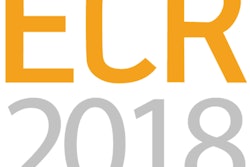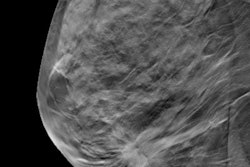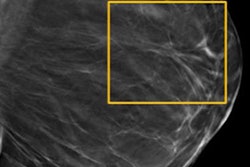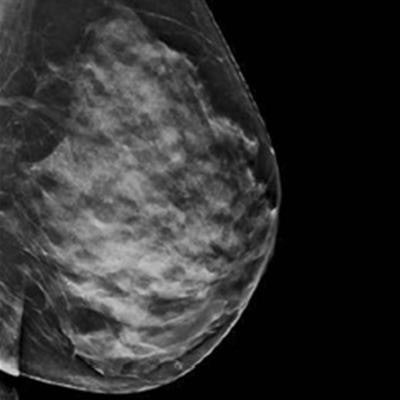
Synthetic 2D images derived from digital breast tomosynthesis (DBT) are comparable with full-field digital mammography (FFDM), according to Spanish researchers. Furthermore, synthetic images could replace FFDM in studies that use both modalities and reduce radiation dose by 45%, they said.
The study team compared synthetic 2D images with FFDM in terms of lesion detectability and BI-RADS lesion categorization. The group, led by Dr. Julia Garayoa from the radiological protection unit at Hospital Universitario Fundación Jiménez Díaz in Madrid, found synthetic images are "not inferior" to FFDM.
"In this work, we demonstrate that the clinical performance of synthetic images is not inferior to that of FFDM images for lesion visibility or BI-RADS categorization," she and her colleagues wrote (European Radiology, 15 August 2017).
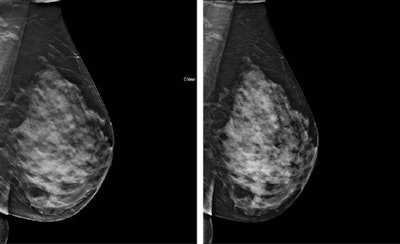 Synthetic (left) and FFDM (right) mediolateral oblique images of a 51-year-old woman. All images courtesy of Dr. Julia Garayoa.
Synthetic (left) and FFDM (right) mediolateral oblique images of a 51-year-old woman. All images courtesy of Dr. Julia Garayoa.How synthetic 2D stacks up
As DBT gains in popularity, the question becomes more and more: Can radiologists ditch FFDM? Most studies examine DBT plus FFDM, but few compare synthetic 2D images with FFDM alone, without access to DBT, to see how synthetic 2D fares.
Garayoa and colleagues sought to evaluate the clinical performance of synthetic images alone compared with FFDM alone in terms of lesion detectability and BI-RADS lesion categorization.
In the single center study, they used 2,384 images to directly compare synthetic 2D images with FFDM. They used multiple reader, multiple case receiver operating characteristic (ROC) to compare the diagnostic performance of the images. All images were acquired on a Selenia Dimensions DBT system (Hologic).
The images revealed the following:
- 121 nodules
- 42 microcalcifications
- 24 distortions
- 13 focal densities
- 77 invasive ductal carcinoma (IDC)
- 7 ductal carcinoma in situ (DCIS)
- 11 infiltrating lobular carcinoma
- 6 IDC + DCIS
- 18 other cancers
Substantial interreader agreement existed for nodule and microcalcifications detectability in both FFDM and synthetic 2D, while fair to moderate agreement existed for densities, distortions, and nodule plus microcalcification findings.
| Interreader agreement for BI-RADS and lesion detectability | ||
| FFDM kappa coefficient | Synthetic 2D kappa coefficient | |
| BI-RADS | 0.70 | 0.76 |
| Nodule | 0.63 | 0.67 |
| Microcalcification | 0.75 | 0.70 |
| Nodule + micro | 0.49 | 0.36 |
| Distortion | 0.45 | 0.53 |
| Density | 0.38 | 0.29 |
The researchers also found almost perfect intrareader agreement for all readers for BI-RADS categorization and lesion detectability.
An insignificant statistical difference (-0.014) existed between the area under the curve (AUC) of the two modalities across the three readers for BI-RADS categorization, proving synthetic 2D is noninferior to FFDM. Similarly, an insignificant statistical difference (-0.001) existed between the AUC of the two modalities across the three readers for lesion visibility.
In addition, although on average FFDM demonstrated a higher sensitivity (79%) than synthetic 2D images (75%), the results were not statistically significant.
| Mean sensitivity and specificity for both modalities | ||
| FFDM | Synthetic 2D | |
| Malignant lesions, BI-RADS 4-5 sensitivity | 0.83 | 0.79 |
| Benign lesions + no lesions, BI-RADS 1-3 specificity | 0.88 | 0.88 |
| Malignant lesions, BI-RADS 5 sensitivity | 0.58 | 0.63 |
| No lesions, BI-RADS 1, specificity | 0.81 | 0.86 |
The results demonstrate synthetic 2D images may replace FFDM images in DBT exams, causing substantial dose savings of 40% to 45%, according to the authors. However, they noted that the study conclusions are only valid for the Hologic unit they used in this research and may not apply to other vendors' equipment.
The results swayed Garayoa and colleagues so much that they no longer conduct two-view DBT plus FFDM at their institution -- they only use DBT with synthetic 2D.
Future research could study the performance of one-view DBT versus two-view DBT to test diagnostic capability, they wrote.
Study disclosures
Study co-author Najim Amallal El Ouahabi declares a relationship with the company EMSOR, representative of Hologic in Spain. The rest of the study authors declare no relationships with any companies whose products or services may be related to the subject matter of the article.





